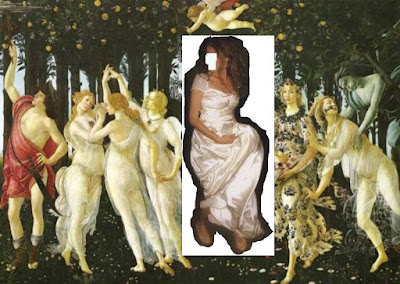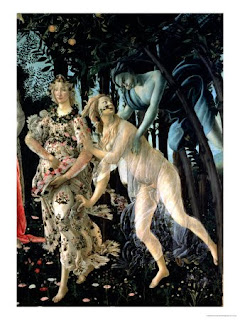
World-renowned 'Early Renaissance' painter Sandro Botticelli (1445-1510), was an Italian Florentine artist, whose artistic prowess remained in oblivion posthumously for almost four hundred years. Historian Alexis-François Rio unveiled Botticelli before the world. 'Renaissance' was one of the most influential movements, encompassing the entire gamut of artistic faculties and culture as a whole. Sandro's works were mostly centered on religious and mythological themes. In line with the then prevailing customs of art, they also focused on the thematic representation of mythologies through detailed human forms and elaborate backgrounds. Botticelli is best known for his paintings, "Primavera" and "The Birth of Venus."

Primavera is large 80" X 124" piece, presently displayed at Galleria degli Uffizi, Florence, Italy. This magnificent painting was created in 1482, on a wood panel as the support and tempera surface (made of thin layer of plaster blended with egg yolk and minerals) as the base. This, highly ornate piece of work, representing the onset of the spring season, is painted in rich color scheme and classic 'Symbolism.' "Primavera" finely delineates nine divine figures, clothed in attires that reveal their anatomical structures with near perfection. Each divine icon holds its unique religious significance and philosophical essence.

Primavera is based upon the unfinished poem by Ovid, Fasti. The whole scene of the artwork is set in the Garden of Venus. Though positioned behind all other Gods, Venus is visible as the most prominent, central figure in the painting. At the extreme right is Zephyr (God of Wind), reaching out for Nymph Chloris. According to the myth, Zephyr forcefully abducted Chloris, as his wife. When self-realization and guilt struck Zephyr however, he transformed Chloris into Flora, the Goddess of Spring. Flora is also distinctively featured in "Primavera," as a goddess in floral clothing, spreading fresh flowers as she moves.

Towards the left side of Venus, are the Three Graces (Charites), Aglaea (Splendor), Euphrosyne (Mirth), and Thalia (Good Cheer), depicted in a dancing posture. Cupid is shown hovering over the head of Venus, aiming his bow at the Three Graces, and is just about to release the arrow. At the extreme left side of the painting is standing the guard of the garden, Mercury. Loosely wearing a bright pink colored, flowing drape, he is stretching his right arm to symbolically touch the clouds above. He is depicted wearing divine armor on head and carrying his weapon, a sword. Botticelli's "Primavera" is the true archetype of grace and beauty, which embody the spirit of painting, and is therefore considered among the masterworks of all times.












0 comments:
Post a Comment